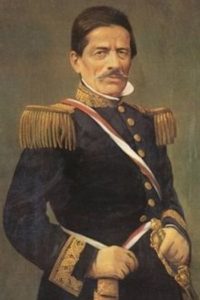
Ramón Castilla y Marquezado
*The abolition of slavery in Peru is celebrated on this date in 1854. Throughout the Middle Passage, approximately 95,000 slaves were brought into Peru, with the last group arriving in 1850.
Often, slaves were initially transported to Cuba and Hispaniola, where traders brought them to Panama and the Viceroyalty of Peru. Planters and others also purchased slaves in Cartagena, Colombia, or Veracruz, Mexico, at trade fairs, and they returned to Peru with the new slaves imported by the slave ships. As a result of the "New Laws" of 1548 and the influence of the denunciation of the abuses against Native Americans by Friar Bartolomé de las Casas, slaves gradually replaced natives at the encomiendas.
Slave owners in Peru developed preferences to enslave people from specific areas of Africa (believed to have certain characteristics); they wanted to have slaves from one area who could communicate with each other. They believed enslaved people from Guinea, from the Senegal River down to the Slave Coast, were easier to manage and had marketable skills. They already knew how to plant and cultivate rice, train horses, and herd cattle on horseback. The enslavers also preferred slaves from the area stretching from Nigeria to eastern Ghana. The enslavers' third choice was for slaves from Congo, Mozambique, Madagascar, and Angola.
In the 17th century, some owners began the process of manumission of people of color. In some cases, enslaved people were allowed to buy their freedom, and a free Afro Peruvian social class emerged. Enslaved people had to pay a high amount to buy their freedom; some were allowed to earn money on the side or, if leased out, keep a portion of their earnings. Others raised loans, and their master granted them some freedom. Even when free, independent Blacks were not considered equal to Spaniards.
Free nonwhites enjoyed equal privileges in certain aspects; for instance, there are records of free Africans buying and selling land. Freed Blacks engaged in various entrepreneurial activities, of which trade was a significant factor. Some people of African descent became owners of shops. However, the status of a free citizen brought new challenges and conditions that a man of color had to face. A freed person of color needed to have a job was required to pay the tribute, and was called to serve in the militia to defend the state. All were under the supervision of the Holy Office.
The Crown raised revenues from the freed Black population. A decree that compelled former slaves to hire themselves out to and reside with a Spaniard master was another way to limit the freedom of emancipated Blacks. While some stayed with the Spanish to save money, the majority successfully defied the rule and began building "joint communities" to support each other. A discrimination policy with a significant and long-term impact was the exclusion of Blacks and mulattoes from education. Universities and schools run mainly by the Church forbade the nonwhite population to enroll, claiming they were "unworthy of being educated." However, wealthy, skilled, capable mulattoes made their way through the political ladder and occupied minor official posts.
In 1821, General José de San Martín outlawed the slave trade in Peru. In 1835, President Felipe Santiago Salaverry signed a decree again legalizing the deportation of slaves through other Latin American countries. Two years after his death, the principle of "emancipating soil," according to which a slave entering Peru is, de facto, made free, was removed from the constitution. In 1854, President Ramón Castilla y Marquezado (pictured) declared slavery abolished.